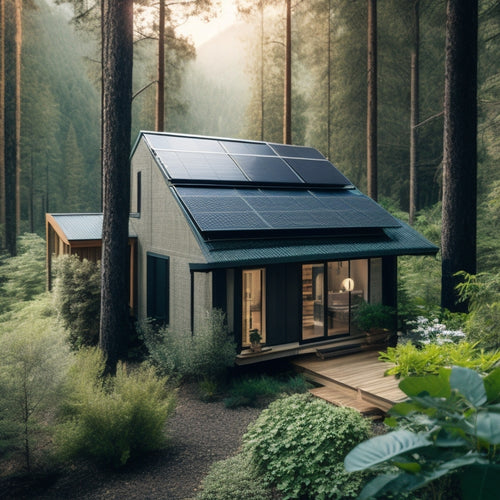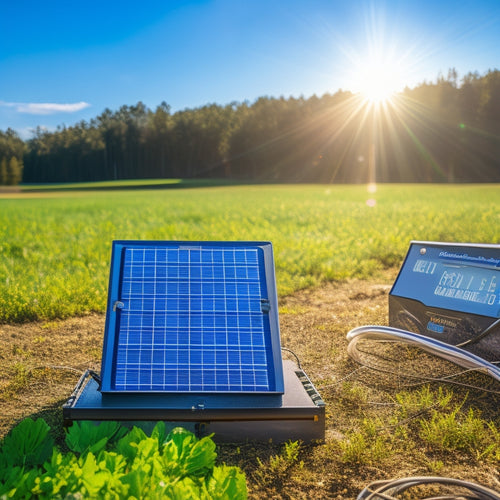
Maintaining Home Energy Independence on a Budget
Share
You're taking control of your energy bills and investing in home energy independence, but you're also on a budget, which means you need a strategic approach to maximize your savings while minimizing upfront costs. By evaluating your energy needs, you can determine the right system size and financing options to reduce initial costs, potentially saving up to 50% over the system's lifespan. Creating a monthly budget and prioritizing energy-saving investments can also lead to long-term savings. To maintain energy independence on a budget, it's crucial to monitor system performance, extend battery lifespan, and stay informed about government programs and incentives - and there's more to investigate to optimize your energy independence.
Overview
- Evaluating energy needs and prioritizing energy-saving investments can lead to long-term savings and energy independence on a budget.
- Solar panel financing options and tax credits can reduce initial costs, making renewable energy more accessible to homeowners.
- Conducting an energy audit and implementing energy-efficient measures like sealing air leaks and upgrading to ENERGY STAR appliances can reduce energy consumption.
- Regular solar panel maintenance, including cleaning and inspection, is crucial to optimize energy output and extend the system's lifespan.
- Behavioral changes like turning off lights and unplugging devices when not in use can save up to $100 annually and enhance energy independence.
Home Solar Panel Costs
With the rising cost of traditional energy sources, homeowners are increasingly turning to solar power as a means of reducing their reliance on the grid.
You're likely considering solar panels to cut energy costs and gain energy independence. However, the upfront cost of purchasing and installing solar panels can be a significant barrier.
To mitigate this, it's crucial to evaluate energy needs and assess the required system size based on household energy demands. Fortunately, solar panel financing options are available to help you get started.
By investing in solar power, you can save up to 50% on your energy cost saving over the lifespan of the system. With the right financing plan, you can enjoy these savings while minimizing your initial outlay.
Budgeting for Energy Efficiency
You've taken the first step towards energy independence by considering solar panels, but there's more to achieving energy efficiency than just utilizing the sun's power.
To optimize your energy savings, it's crucial to budget for energy efficiency improvements. Start by conducting an energy audit to identify areas of energy loss in your home, which can help you determine required system size and pinpoint high consumption areas for optimization.
This will help you prioritize upgrades, such as sealing air leaks, adding insulation, and upgrading to energy-efficient appliances. Many utility companies offer rebates for energy-efficient upgrades, so be sure to research and take advantage of these incentives.
DIY Solar Panel Maintenance
Beyond the initial investment, solar panels require regular maintenance to secure ideal energy production and longevity. As a homeowner, you can perform some maintenance tasks yourself to guarantee your solar panels operate at peak efficiency.
Start by inspecting your solar panels regularly for signs of debris or damage. It's crucial to monitor performance in real-time to identify trends and potential issues, and to make data-driven optimization decisions.
Regular cleaning can also improve energy output by up to 25%, so clean your solar panels every 6-12 months to prevent energy loss due to dirt and grime buildup. You can use a soft-bristled brush, mild soap, and distilled water for solar panel cleaning. This simple task can improve energy efficiency by up to 15%.
Additionally, check your panels' tilt and orientation to confirm they're optimized for maximum energy production.
Professional Solar Panel Cleaning
Your solar panels are a significant investment, and while DIY maintenance is vital, there are times when professional cleaning is necessary to guarantee peak performance.
To ascertain ideal energy output, consider hiring a professional to clean your solar panels every 6-12 months, depending on your location and environmental conditions.
Regular battery monitoring and maintenance is also fundamental to prevent overcharging and undercharging, which can affect the overall performance of your solar panel system.
Professional services use advanced cleaning techniques and equipment to remove dirt and debris, resulting in improved performance and extended equipment lifespan.
By outsourcing cleaning, you'll also avoid safety risks and potential damage to your panels.
Don't believe the myth that cleaning isn't necessary – regular cleaning can increase energy output by up to 25%.
With the cost benefits of increased energy production and reduced equipment maintenance, professional cleaning is a worthwhile investment for your home's energy independence.
Inverter Replacement Strategies
You'll eventually need to replace your inverter, an essential component of your solar panel system, to maintain energy independence.
When that time comes, you'll have inverter upgrade options to think about, which can improve system performance and efficiency.
Inverter Upgrade Options
Three key inverter upgrade options exist for homeowners seeking to maintain energy independence on a budget.
You can upgrade to a more efficient inverter, taking advantage of inverter technology trends that provide higher power output and better performance.
Another option is to add a secondary inverter, allowing you to expand your energy storage capacity and increase your energy independence.
Alternatively, you can consider upgrading to a hybrid inverter, which can handle both grid-tied and off-grid operations.
When choosing an upgrade option, consider inverter sizing considerations to guarantee the new inverter can handle your energy needs.
Cost-Effective Replacement
Upgrading an inverter can be a costly undertaking, but a well-planned replacement strategy can help mitigate the expenses.
You can start by evaluating your energy needs and identifying areas for improvement. Consider upgrading to energy-efficient appliances and implementing home insulation upgrades to reduce your energy consumption. This won't only lower your energy bills but also reduce the load on your inverter, allowing you to opt for a smaller, more cost-effective replacement.
Additionally, look for inverters with high efficiency ratings and consider purchasing a refurbished or certified pre-owned unit.
Monitoring System Performance
As your energy independence system begins generating power, it's essential to keep a close eye on its performance to verify peak energy production and detect any potential issues early on.
You'll want to implement system diagnostics to monitor performance metrics such as energy output, voltage, and temperature. This will help you identify areas for improvement and catch any problems before they escalate.
Regularly review your system's performance data to confirm it's running efficiently and make adjustments as needed.
Extending Battery Lifespan
You can considerably extend the lifespan of your batteries by implementing effective charge cycle management and ideal depth discharge strategies.
By doing so, you'll reduce the wear and tear on your batteries, minimizing capacity loss over time.
Charge Cycle Management
By optimizing charge cycles, homeowners can greatly prolong the lifespan of their energy storage systems, thereby ensuring a reliable and efficient supply of power when needed.
Proper charge cycle management allows you to maximize the benefits of your energy storage system while minimizing wear and tear.
By avoiding extreme charge and discharge cycles, you can reduce battery degradation and extend its lifespan.
Effective charge cycle optimization also enables you to optimize your energy usage patterns, reducing waste and saving you money.
Optimal Depth Discharge
Optimizing charge cycles is just the first step in maintaining a reliable and efficient energy storage system.
You're now ready to tackle ideal depth discharge, an essential aspect of extending battery lifespan. The key is to avoid extreme depth of discharge (DOD), which can reduce your battery's overall capacity.
Aim for a moderate DOD, typically between 20% and 80%, to minimize wear and tear. Be mindful of your battery chemistry, as different types respond better to varying discharge rates.
For example, lead-acid batteries can handle higher discharge rates than lithium-ion batteries. By controlling discharge rates and avoiding deep cycles, you'll prolong your battery's lifespan and maintain your energy independence.
Frequently Asked Questions
Can I Install Solar Panels on a Rented Property?
You can investigate solar panel options for your rented property, but first, review your rental agreements to guarantee you're allowed to make modifications, and consider obtaining written permission from your landlord before installation.
Are Energy-Efficient Appliances Worth the Extra Cost?
As you flip the switch on your time machine, catapulting back to the era of incandescent bulbs, you'll realize energy-efficient appliances are worth the extra cost, yielding significant energy savings and a longer appliance lifespan, freeing you from the shackles of utility bills.
How Do I Handle Solar Panel Repairs During a Warranty?
When handling solar panel repairs during a warranty, you'll want to review your warranty coverage to understand what's included and what's not, ensuring you're not stuck with unexpected repair costs that could drain your savings.
Will Energy Independence Increase My Property Value?
You'll likely see an increase in property value as energy independence enhances your home's appeal; a property appraisal will reflect the value of your renewable investments, making your home more attractive to potential buyers.
Can I Use Solar Power for My Electric Vehicle Charging?
Savvy shoppers seeking sustainable solutions, you can seamlessly switch to solar charging for your electric vehicle, leveraging photovoltaic panels to power your EV's battery, and slashing reliance on the grid.
Ready to Buy
By following these cost-effective strategies, you'll be utilizing the power of the sun like a skilled sailor steering through calm waters. Maintaining home energy independence on a budget requires a proactive approach, from DIY maintenance to inverter replacement planning. By staying on top of system performance and extending battery lifespan, you'll guarantee a smooth sail towards energy self-sufficiency. So, chart your course, stay vigilant, and enjoy the fruits of your labor – a wallet-friendly and sustainable energy future.
Related Posts
-

Why Outdoor Solar Lighting Systems Are Sustainable
Outdoor solar lighting systems are sustainable because they utilize renewable energy, drastically reducing your carbo...
-

Off Grid Solar Batteries
As you shift to off-grid living, you'll rely on high-performance solar batteries to store excess energy generated by ...
-

Choosing the Right Solar Power Charge Controller
Choosing the right solar power charge controller is crucial for maximizing energy efficiency and extending battery li...


